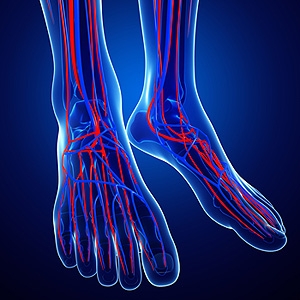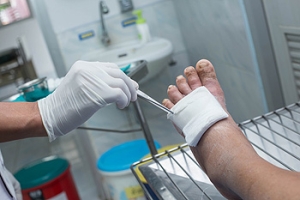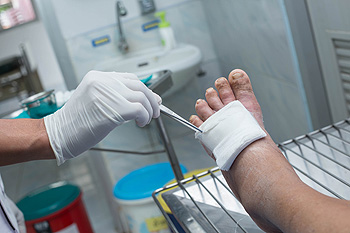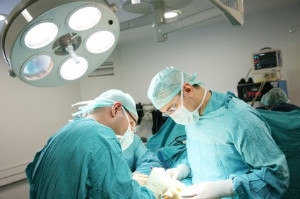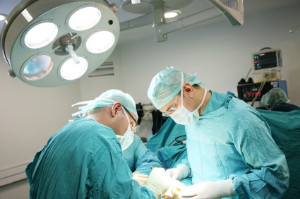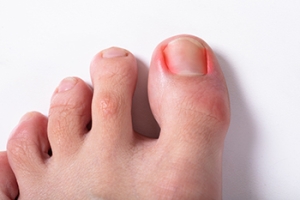
Poor Circulation and the Lower Extremities
 There are a few telling signs that may indicate you are experiencing poor circulation in your lower legs and feet. Common symptoms of poor circulation may include fatigue or cramping during physical activity, cramping during inactivity, swelling and achiness, tingling, and a persistent coldness. Poor circulation can make going about your everyday activities incredibly uncomfortable and can be an indicator of more serious health concerns. A lack of feeling or numbness can also develop in your lower extremities, increasing the risk of wounds going undetected. If wounds develop on your feet and are left untreated, it’s possible they may become infected, which can lead to serious complications down the road. For professional advice on how to treat poor circulation in your lower legs and feet, please speak with a podiatrist.
There are a few telling signs that may indicate you are experiencing poor circulation in your lower legs and feet. Common symptoms of poor circulation may include fatigue or cramping during physical activity, cramping during inactivity, swelling and achiness, tingling, and a persistent coldness. Poor circulation can make going about your everyday activities incredibly uncomfortable and can be an indicator of more serious health concerns. A lack of feeling or numbness can also develop in your lower extremities, increasing the risk of wounds going undetected. If wounds develop on your feet and are left untreated, it’s possible they may become infected, which can lead to serious complications down the road. For professional advice on how to treat poor circulation in your lower legs and feet, please speak with a podiatrist.
While poor circulation itself isn’t a condition; it is a symptom of another underlying health condition you may have. If you have any concerns with poor circulation in your feet contact Dr. Thomas E. Silver of Westwood Foot Clinic. Our doctor will treat your foot and ankle needs.
Poor Circulation in the Feet
Peripheral artery disease (PAD) can potentially lead to poor circulation in the lower extremities. PAD is a condition that causes the blood vessels and arteries to narrow. In a linked condition called atherosclerosis, the arteries stiffen up due to a buildup of plaque in the arteries and blood vessels. These two conditions can cause a decrease in the amount of blood that flows to your extremities, therefore resulting in pain.
Symptoms
Some of the most common symptoms of poor circulation are:
- Numbness
- Tingling
- Throbbing or stinging pain in limbs
- Pain
- Muscle Cramps
Treatment for poor circulation often depends on the underlying condition that causes it. Methods for treatment may include insulin for diabetes, special exercise programs, surgery for varicose veins, or compression socks for swollen legs.
As always, see a podiatrist as he or she will assist in finding a regimen that suits you. A podiatrist can also prescribe you any needed medication.
If you have any questions, please feel free to contact our office located in Golden Valley, MN . We offer the newest diagnostic and treatment technologies for all your foot care needs.
Causes Symptoms and Treatment for Poor Circulation in the Feet
The purpose of the body’s circulation system is to transport blood, oxygen, and nutrients throughout the body. A reduction of blood to a specific part of the body may cause one to experience symptoms of poor circulation. The most common causes of poor circulation in the feet are obesity, diabetes, and heart conditions such as peripheral artery disease (PAD). Common symptoms of poor circulation include tingling, numbness, throbbing, pain and muscle cramps.
Peripheral artery disease is a common cause of poor circulation in the legs. Symptoms of PAD are cramping, pain or tiredness in the leg or hip muscles while walking or climbing stairs. This pain tends to go away with rest and starts back up when you begin to walk. It is a condition that causes the blood vessels and arteries to become narrow. Although PAD is more common in adults over the age of 50, it may also occur in younger people. A similar condition called atherosclerosis causes arteries to stiffen up due to a buildup of plaque in the arteries and blood vessels.
Blood clots are also a common cause of poor circulation in the feet. Clots may obstruct blood vessels and if they occur in the legs, they may eventually lead to pain and discoloration. This occurrence is commonly known as deep vein thrombosis (DVT) and it may travel to the lungs. Varicose veins are another condition that may lead to poor circulation, and it is caused by incompetence of the valves in the veins. Women who are overweight are prone to developing this condition. Lastly, diabetes, which is correlated with poor blood sugar metabolism may lead to chronic poor circulation. Those with diabetes often suffer from cramping in the legs, calves, thighs and buttocks.
If you are looking for ways to avoid poor circulation there are some tips you can follow. One tip is to avoid sitting for too long. If you plan to sit down for a long period of time, you should try standing up occasionally, to improve your circulation. Another great way to avoid poor circulation is to exercise. Exercise is an excellent way to pump the heart and increase blood flow. Those who suffer from poor circulation should also avoid smoking, reduce their salt intake, and try to lose weight.
If you are experiencing symptoms from poor circulation in your feet, you should consult with your podiatrist to determine the best method for treatment for you. He or she may prescribe medication in addition to recommending specific lifestyle changes to improve your circulation.
Different Types of Diabetic Foot Ulcers
Diabetic foot ulcers are slow healing wounds that appear on the feet of individuals with diabetes and can become a very serious health issue. Almost a quarter of all individuals diagnosed with diabetes will develop a foot ulcer at some point in their life. There are several types of diabetic foot ulcers, and knowing which type you have can help determine the most effective treatment. Neuropathic ulcers occur when nerve damage from diabetic neuropathy prevents the patient with diabetes from feeling pain from an injury. This allows the wound to progress before you are even aware of it, increasing the risk of infection. Ischemic ulcers may be caused by a lack of blood flow to the feet. These types of ulcers are often difficult to heal. Neuroischemic ulcers are the most difficult to heal and occur in individuals who have both neuropathy and poor circulation. Infected wounds occur in half of diabetic patients with foot ulcers, and require close medical attention. If you have diabetic foot ulcers, it is highly recommended that you are under the care of a podiatrist who can help you look after your wounds and prevent severe complications.
Wound care is an important part in dealing with diabetes. If you have diabetes and a foot wound or would like more information about wound care for diabetics, consult with Dr. Thomas E. Silver from Westwood Foot Clinic. Our doctor will assess your condition and provide you with quality foot and ankle treatment.
What Is Wound Care?
Wound care is the practice of taking proper care of a wound. This can range from the smallest to the largest of wounds. While everyone can benefit from proper wound care, it is much more important for diabetics. Diabetics often suffer from poor blood circulation which causes wounds to heal much slower than they would in a non-diabetic.
What Is the Importance of Wound Care?
While it may not seem apparent with small ulcers on the foot, for diabetics, any size ulcer can become infected. Diabetics often also suffer from neuropathy, or nerve loss. This means they might not even feel when they have an ulcer on their foot. If the wound becomes severely infected, amputation may be necessary. Therefore, it is of the upmost importance to properly care for any and all foot wounds.
How to Care for Wounds
The best way to care for foot wounds is to prevent them. For diabetics, this means daily inspections of the feet for any signs of abnormalities or ulcers. It is also recommended to see a podiatrist several times a year for a foot inspection. If you do have an ulcer, run the wound under water to clear dirt from the wound; then apply antibiotic ointment to the wound and cover with a bandage. Bandages should be changed daily and keeping pressure off the wound is smart. It is advised to see a podiatrist, who can keep an eye on it.
If you have any questions, please feel free to contact our office located in Golden Valley, MN . We offer the newest diagnostic and treatment technologies for all your foot care needs.
Wound Care
Diabetics must be wary of all wounds, regardless of depth or size. Diabetes, a chronic disease in which the body cannot properly use glucose the way it normally would, causes various complications that make wounds difficult to heal. Nerve damage or neuropathy will cause diabetics to have trouble feeling the pain of a blister or cut until the condition has significantly worsened or become infected. A diabetic’s weakened immune system can make even the most minor of wounds easily susceptible to infection. Diabetics are also more prone to developing narrow, clogged arteries, and are therefore more likely to develop wounds.
Wounds should be taken care of immediately after discovery, as even the smallest of wounds can become infected if enough bacteria build up within the wound. To remove dirt, wounds should be first rinsed under running water only. Soap, hydrogen peroxide, or iodine can irritate the injury and should be avoided. To prevent infection, apply antibiotic ointment to the wound and cover it with a bandage. The bandage should be changed daily. The skin around the wound may be cleaned with soap.
To prevent further exacerbation, see a doctor—especially if you have diabetes. Minor skin conditions can become larger problems if not properly inspected. As the wound heals, make sure to avoid applying pressure to the affected area.
Are You Suffering From Ingrown Toenails?
What Is Total Ankle Replacement?
Total ankle replacement is a surgical procedure in which a defective ankle joint is removed and replaced with plastic or metal pieces. This surgery is usually done to combat pain and disability from late-stage ankle arthritis. People with this condition often have such significant joint degeneration that they can barely move their ankle. During the procedure, the surgeon removes the diseased lower part of the shin bone (tibia) and upper part of the foot bone (talus), then replaces them with an artificial joint. Recovery can be a lengthy process. It often takes at least 4 months to return to full activity. Nevertheless, those who undergo the procedure often find that their increased mobility and reduced pain is worth it. To learn more about total ankle replacement please consult with a podiatrist today!
In certain cases, in which the patient suffers from extreme pain or damage in a joint, joint replacement surgery may be deemed useful. If you have constant pain in a foot joint, consult with Dr. Thomas E. Silver from Westwood Foot Clinic. Our doctor will assess your condition and provide you with quality foot and ankle treatment.
What Is Joint Replacement Surgery?
Over time, joints wear down; this can be exacerbated by diseases and conditions. Joint replacement surgery, also known as arthroplasty, is when a damaged joint is surgically removed and replaced with a prosthesis. Prostheses, which can be made of ceramic, plastic, or metal, act as joints in lieu of an actual joint. One of the most prevalent causes for joint replacement is arthritis.
Arthritis in the Foot
Arthritis can occur in any joint in the body, including in the feet. Common types of arthritis in the foot are osteoarthritis, rheumatoid arthritis, and gout. The big toe is usually where arthritis occurs in the foot; this is known as hallux rigidus.
Joint Replacement Surgery in the Foot
The most common form of joint replacement in the foot is a first metatarsophalangeal (MTP) joint placement. MTP joint replacement surgery is designed to treat hallux rigidus. Surgery is not intensive, and recovery occurs within one to two months after the procedure has been done. Overall, joint replacement surgery is a safe and effective way to treat pain in the joint of the foot.
If you have any questions, please feel free to contact our office located in Golden Valley, MN . We offer the newest diagnostic and treatment technologies for all your foot care needs.
Joint Replacement Surgery
When conservative, noninvasive treatments prove unsuccessful, podiatrists will often turn to surgery as the last line of treatment for their patients. If patients are suffering from joint pain, issues in mobility, or are seeking to correct a deformity, joint replacement surgery is an effective option. Joint replacement surgery is also successful in treating arthritis, which is the most common cause of improperly working joints.
Patients with symptoms that include joint pain, stiffness, limping, muscle weakness, limited motion, and swelling are typically considered for joint replacement surgery. Range of motion and activity post-surgery will vary between patients and depending on the specific surgery performed, the affected joint, and the damage that will need to be repaired.
Joint replacement surgery replaces the damaged cartilage and bone, the latter if required. The damaged cartilage is typically replaced with a prosthesis that is attached to the bone, allowing the implant to grow into the bone. Following surgery, the patient will typically undergo physical therapy to become familiar with movement using the replaced joint.
Why Do Ingrown Toenails Form?
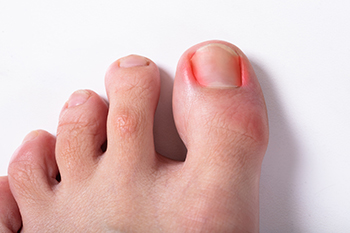 An ingrown toenail is the result of a curved toenail that grows down into the skin on the sides of the nail. As the toenail digs deep into the skin and the skin continues to grow around it; pain, redness, and swelling can occur. In severe cases, this can lead to an infection that is often indicated by a pus or drainage and usually coincides with a bad odor. Ingrown toenails can have different causes that include trauma to the toe, improperly trimmed nails that are cut too short or on a curve instead of straight across, and footwear that is too tight. The tendency for ingrown toenails may also be inherited or caused by other nail conditions, such as fungal nails. Patients who experience an infection, or those who have recurring ingrown toenails should visit a podiatrist for treatment. A podiatrist can determine what course of treatment is correct for you, as well as administer the proper medication to cease an infection and any corresponding pain.
An ingrown toenail is the result of a curved toenail that grows down into the skin on the sides of the nail. As the toenail digs deep into the skin and the skin continues to grow around it; pain, redness, and swelling can occur. In severe cases, this can lead to an infection that is often indicated by a pus or drainage and usually coincides with a bad odor. Ingrown toenails can have different causes that include trauma to the toe, improperly trimmed nails that are cut too short or on a curve instead of straight across, and footwear that is too tight. The tendency for ingrown toenails may also be inherited or caused by other nail conditions, such as fungal nails. Patients who experience an infection, or those who have recurring ingrown toenails should visit a podiatrist for treatment. A podiatrist can determine what course of treatment is correct for you, as well as administer the proper medication to cease an infection and any corresponding pain.
Ingrown toenails may initially present themselves as a minor discomfort, but they may progress into an infection in the skin without proper treatment. For more information about ingrown toenails, contact Dr. Thomas E. Silver of Westwood Foot Clinic. Our doctor can provide the care you need to keep you pain-free and on your feet.
Ingrown Toenails
Ingrown toenails are caused when the corner or side of a toenail grows into the soft flesh surrounding it. They often result in redness, swelling, pain, and in some cases, infection. This condition typically affects the big toe and may recur if it is not treated properly.
Causes
- Improper toenail trimming
- Genetics
- Improper shoe fitting
- Injury from pedicures or nail picking
- Abnormal gait
- Poor hygiene
You are more likely to develop an ingrown toenail if you are obese, have diabetes, arthritis, or have any fungal infection in your nails. Additionally, people who have foot or toe deformities are at a higher risk of developing an ingrown toenail.
Symptoms
Some symptoms of ingrown toenails are redness, swelling, and pain. In rare cases, there may be a yellowish drainage coming from the nail.
Treatment
Ignoring an ingrown toenail can have serious complications. Infections of the nail border can progress to a deeper soft-tissue infection, which can then turn into a bone infection. You should always speak with your podiatrist if you suspect you have an ingrown toenail, especially if you have diabetes or poor circulation.
If you have any questions, please feel free to contact our office located in Golden Valley, MN . We offer the newest diagnostic and treatment technologies for all your foot care needs.




